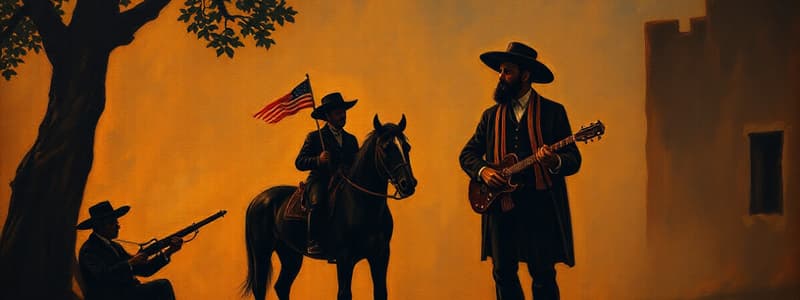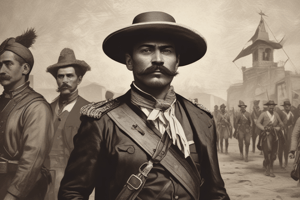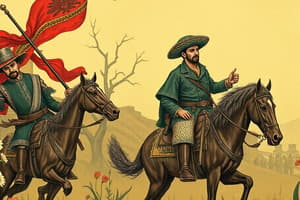Podcast
Questions and Answers
What characterized the years following the ouster of Victoriano Huerta in the context of the Mexican Revolution?
What characterized the years following the ouster of Victoriano Huerta in the context of the Mexican Revolution?
- The establishment of a stable government under Carranza.
- A time of significant economic progress and peace.
- The most chaotic phase marked by internal quarrels. (correct)
- A period of strong unity among revolutionary leaders.
How did Zapata and Villa differ in their approaches during the revolution?
How did Zapata and Villa differ in their approaches during the revolution?
- Both leaders sought economic reforms equally.
- Zapata was more focused on agrarian reform while Villa pursued a wider range of social interests. (correct)
- Villa focused on agrarian reform while Zapata had a broader agenda.
- Zapata was aggressive while Villa was cautious.
What was the result of the alliance between Zapata and Villa against Carranza?
What was the result of the alliance between Zapata and Villa against Carranza?
- It led to a strengthened government under Carranza.
- They quickly expelled Carranza from power.
- The alliance produced no significant military cooperation. (correct)
- It resulted in a successful military campaign.
What were some commonly noted traits of Villa according to the content?
What were some commonly noted traits of Villa according to the content?
What impact did the early months of 1915 have on the Mexican Revolution?
What impact did the early months of 1915 have on the Mexican Revolution?
What were the immediate consequences of the attack on the town by Villistas?
What were the immediate consequences of the attack on the town by Villistas?
What was the main point of disagreement between Zapata and Villa?
What was the main point of disagreement between Zapata and Villa?
What was the main reason for the increased desire for US intervention in Mexico as mentioned in the text?
What was the main reason for the increased desire for US intervention in Mexico as mentioned in the text?
Which statement accurately describes the characteristics of Emiliano Zapata, as depicted in the text?
Which statement accurately describes the characteristics of Emiliano Zapata, as depicted in the text?
What is the meaning of the term "Villistas" as used in the text?
What is the meaning of the term "Villistas" as used in the text?
What is the main objective of the text?
What is the main objective of the text?
What does the word "atrocities" imply about the actions committed by the Villistas?
What does the word "atrocities" imply about the actions committed by the Villistas?
What does the sentence "They have always been the scourge of the people" imply about the Villistas' actions?
What does the sentence "They have always been the scourge of the people" imply about the Villistas' actions?
What type of writing style is used in the text?
What type of writing style is used in the text?
Based on the text, how did the actions of Villistas influence the US government's decision to intervene in Mexico?
Based on the text, how did the actions of Villistas influence the US government's decision to intervene in Mexico?
Flashcards
Convention of Aguascalientes
Convention of Aguascalientes
A gathering of revolutionary leaders in 1914 to discuss the future of Mexico, designed to unify the movement but ultimately failed due to conflicting ideologies and personalities.
Pancho Villa
Pancho Villa
A charismatic and influential revolutionary leader, known for his courage and fierce loyalty, who embodied the frontier code of honor, violence and vengeance.
Emiliano Zapata
Emiliano Zapata
A revolutionary leader who prioritized agrarian reform and fought for the rights of peasants. He was known for his cautious and resolute leadership, always striving to stay true to his promises.
Mexican Revolution's Anarchy
Mexican Revolution's Anarchy
Signup and view all the flashcards
Venustiano Carranza
Venustiano Carranza
Signup and view all the flashcards
Civilian casualties
Civilian casualties
Signup and view all the flashcards
Atrocities
Atrocities
Signup and view all the flashcards
Punitive expedition
Punitive expedition
Signup and view all the flashcards
Violence
Violence
Signup and view all the flashcards
Honor
Honor
Signup and view all the flashcards
Vengeance
Vengeance
Signup and view all the flashcards
Resolute
Resolute
Signup and view all the flashcards
Impetuous
Impetuous
Signup and view all the flashcards
Study Notes
Chapter 10: The Illusory Quest for a Better Way
- The years following Victoriano Huerta's rule were chaotic in Mexican history, marked by conflicts amongst revolutionary allies.
- In 1914, Venustiano Carranza proposed a convention in Aguascalientes to unite revolutionary factions and choose a provisional president.
- Delegates, reflecting different revolutionary aims (Zapatistas and Villistas versus Carrancistas and Obregonistas), attended.
- The conference saw significant debates about the future direction of the Mexican Revolution.
- A key disagreement involved the Zapatistas arguing that Villa and Zapata were the revolution's true leaders.
- The vice chair of the Zapatista delegation, Antonio Díaz Soto y Gama, articulated future goals for combat.
Studying That Suits You
Use AI to generate personalized quizzes and flashcards to suit your learning preferences.




